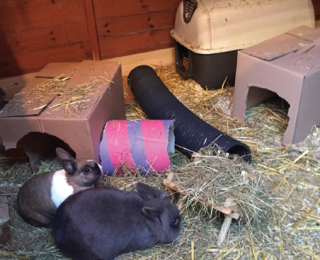Small animal - May 2020
Companion rabbits: a case study concerning human-directed aggression
Deborah J N Fry BSc (Hons) MSc CCAB, certificated clinical animal behaviourist, presents a case study that explores human-directed aggression in a companion rabbit. It highlights how, when assessing and treating problem behaviour, it is essential to consider the natural habitat, biology and behaviour of wild rabbits in relation to companion rabbit management
Click on image to view
The 2019 PDSA Wellbeing Report (PDSA, 2019) identified that, in the UK, rabbits remain the third most popular mammalian pet; with 2% of households owning at least one rabbit and 900,000 rabbits owned. A prior study also identified that c.35,000 rabbits are relinquished to UK rescue centres annually (Copping, 2009) – a figure not accounting for relinquishment to other sources. It was not possible for this author to find similar statistics for the Republic of Ireland. A primary reason for rabbits being relinquished or confined to a hutch without company is due to behaviour, particularly aggression towards caregivers.
Wild and domesticated rabbit comparisons
Rabbits were domesticated some 1,500 years ago (Carneiro et al, 2011). They originate from the European wild rabbit, a social burrowing herbivore native to the Iberian Peninsula. This habitat produces forage of relatively poor quality, therefore rabbits evolved to spend up to 12 hours per day foraging, grazing and in refection (McBride, 2000).
Rabbits are natural prey for many species and are adapted regarding their anatomy, physiology and behaviour to avoid predation (Meredith, 2014). They have highly developed senses which, with opportunity, they use to regularly scan their environment (Somers et al, 2012). In rabbits not altered by selective breeding, ears are large and erect to funnel sound and alert the rabbit to predators. Ears can move independently of one another, and swivel to accurately detect where sounds and danger are located (Meredith, 2014). The rabbit’s lateral eye positioning allows a wider field of vision and, as a crepuscular species, their sight is adapted for dawn and dusk light intensities. Rabbits have a 60-degree caudal blind spot, which reduces when elevating their ears during periscoping (hind-leg standing or sitting).
Olfaction is an important means of avoiding predation in wild rabbits. When above ground to eat, socialise, court and mate, they position themselves downwind of scent and their noses twitch to detect scents; the latter can correspond with apprehension levels (McBride, 1986). Rabbits have cleft upper lips to enhance moisture and olfaction.
Wild rabbits often live in groups of two to 14 individuals in underground warrens with multiple entrance/exit areas (McBride, 1986). They have an above-ground home range of c.2,185m2 and 1,580m2 for males and females, respectively (Myers & Poole, 1961). They maintain stable social bonds through allogrooming and resting with physical contact. Rabbits chin-rub objects to transfer scent-gland secretions (Hoffman et al, 2010) and deposit scent in faecal-accumulation latrines to maintain group intensity (Ruiz-Aizpurua et al, 2013). They can spray urine at intruders or during courtship (McBride, 2014). Rabbits naturally respond to fear-evoking stimuli by freezing or fleeing and alerting conspecifics with hind-leg thumps, although defensive aggression can occur without escape opportunity. They may then use ascending signals including muscle-tension, posturing, vocalisations and biting (McBride et al, 2010). Rabbits can display tonic immobility if caught by a predator (Everitt, 2014).
Despite domestication, the behavioural repertoires of wild and domesticated rabbits barely differ (McBride, 2000; Bigler & Oester, 1996). This relates to anti-predation, sociality and home range. However, selective breeding and morphologies deviating from the ‘normal rabbit’ may impact stress, which over time may alter health. For example, lop-eared rabbits may be more anxious as their ears are less effective in funnelling sound, and the vision-range in Lionhead rabbits may be restricted by hair. This theory seems underexplored. Common husbandry practices for companion rabbits include keeping them singularly and in housing which limits opportunity for avoidance, locomotion and vigilance. A rabbit unable to access sanctuary or perform highly motivated behaviours, including foraging, burrowing and social behaviours, may be acutely or chronically stressed.
Assessing problem behaviour in companion rabbits
When assessing problem behaviour in companion rabbits, as well as considering health, it is necessary to consider management in relation to the natural habitat, biology and behaviour of wild counterparts. Aggression is commonly-reported, whether directed at caregivers, vets or conspecifics. This is a normal behavioural response to a perceived threat. The underlying emotional state is almost-certainly negative, whether anxiety, fear or frustration.
When diagnosing behavioural disorders in a rabbit, it is necessary to identify the underlying emotional state as well as the rabbit’s motivations at the time they are using aggression. General welfare considerations are also important, not just at the time aggression is being used. If welfare is compromised, the rabbit’s threshold for using aggression will be lowered. A trigger-stacking scenario may be occurring, whereby each individual stressor causes stress hormones to elevate, which then lowers tolerance for subsequent stressors.
CASE STUDY
Josie was a spayed female Dutch-type rabbit, aged 11 months. She had lived with her adult caregiver from the age of eight weeks, and had been successfully paired with a castrated male Lop-type rabbit. Josie was fed a diet of limited concentrated feed, unlimited hay, fresh forage and vegetables. She had access to a large and enriched outdoor exercise area for eight hours daily, during daytime hours. At other times, Josie and her companion were housed in a relatively small hutch, which did not contain complexity. Consequently, this did not allow for appropriate locomotion, scanning and other species-specific behaviours. The hutch and exercise area were not connected, and the rabbits were carried between them.
The problem behaviour was aggression directed at the caregiver, manifesting as lunging, vocalisation and biting. This started when Josie was three months old. Around that time, she experienced two environmental changes. She was brought indoors to be petted, where she failed to cope with slippery flooring and active household appliances, and her hutch was changed from a front-opening design to a top-opening one. Hence, anyone caring for Josie needed to lift the roof and reach in. This same hutch was still being used when I met Josie.
In an attempt to address problem behaviour, Josie’s caregiver had previously arranged for her to be spayed. She had also involved an unqualified behaviourist – who advised that Josie be handled more regularly, with her caregiver wearing protective gloves. The frequency and intensity of Josie’s aggression increased. A vet-referred behaviour consultation was arranged as an alternative to euthanasia. Josie did not suffer from known health issues..
Diagnosis
Josie’s aggressive behaviour was diagnosed as fear- and frustration-based. This considered health, social and environmental factors, the timeline for behaviour-development and the context in which aggression occurred. Deficiencies in size, complexity and enrichment related to Josie’s hutch-limited expression of highly motivated behaviours including scanning and avoidance.
Health considerations
The referring veterinary surgeon had examined Josie and did not identify medical causes for problem behaviour.
Predisposing, initiating and maintaining factors
With any problem behaviour, it is necessary to consider predisposing, initiating and maintaining factors. It is not always possible to identify predisposing factors, but these can include genetic predispositions, morphology, innate tendencies and compromised overall welfare which may predispose a rabbit towards negative emotional states.
It is, similarly, not always possible to identify initiating factors with problem behaviour, including if background information is sparse. However, in Josie’s case, these were identified. As a prey species, Josie found handling stressful. This was exacerbated as her hutch-design changed and her caregiver opened the roof to reach in, mimicking a predator approaching from above. The hutch did not allow avoidance of perceived threats and, therefore, Josie aggressed. She may have initially shown subtle defensive behaviours but being handled regardless taught her to escalate these. Hence, overt aggression was resorted to.
Around the time that Josie’s hutch was changed, she was brought indoors by her caregiver. Josie did not cope well with this and likely associated her fear of indoor stimuli, including slippery flooring, movement, lights, shadows and noisy household appliances, with humans. This resulted in further fear and reactivity.
Maintenance factors with problem behaviour can generally always be identified. Josie’s aggression was maintained by daily rehearsal of fear, frustration and reactivity related to being picked up and the circumstances whereby her hutch did not allow sanctuary or expression of innate behaviours. Her fear was exacerbated by increased handling frequency/intensity as advised by the unqualified behaviourist. This ‘flooding’ method of systematic exposure to feared stimuli is unethical (Grandin, 2009). Rather than desensitising, it can cause further sensitisation or learned helplessness (Bowen and Heath, 2005).
Treatment plan _ Aims
- Maintain safety/minimise rehearsal of negative emotional states
- Improve associations with people
- Provide an optimal environment
Maintain safety/minimise rehearsal of negative emotional states
To maintain safety, Josie’s caregiver needed to avoid picking her up in the short-term, unless essential for health purposes. This was to limit rehearsal of fear, reactivity and injury-risk for all parties. It was recommended that whilst appropriate housing was organised, the hutch be enriched and modified so that it could be opened from the front. It was advised that a plastic pet carrier containing hay (hence, non-slip) and with its door propped open, be put inside. Associations with the pet carrier were optimised using food and by ensuring that people did not reach inside. Josie readily used the pet carrier, including when approached.
For transferral to the exercise area and vice-versa, Josie’s caregiver was asked to approach the hutch in a non-startling manner, gently close the pet-carrier door and transport Josie inside this. The pet-carrier was to be left in the exercise area during the day, before being used to transport Josie back to her hutch in the late afternoon. Josie’s caregiver was advised to wear protective gloves if needing to handle her in the short-term – albeit different ones to those used for ‘flooding’. This would limit injury-risk and allow Josie to predict when she would be touched, meaning she did not need to anticipate this at other times.
Improve associations with people
To improve Josie’s associations with people, desensitisation and counterconditioning were advised. Josie was to be further exposed to her caregiver at dawn and dusk, at a level not causing a negative emotional or behavioural reaction. Her caregiver would need to regularly and passively sit at a distance from the hutch, gradually decreasing this distance over weeks as Josie consistently stayed calm and focused on enjoyable activities. This could progress to her caregiver offering Josie food to promote good associations, before generalising this protocol to daytime hours. When Josie was confidently approaching her caregiver, ‘touch’ could be reintroduced at a level she could manage. Initially, this would be around her forehead and cheeks (areas related to social grooming), progressing to her back/hindquarters.
The ultimate goal was for Josie to tolerate being picked up, if necessary. It was advised that, in future, being stroked should extend to having her hindquarters briefly lifted several centimetres while her caregiver said a distinct verbal cue. This could be paired with good outcomes such as high-value food treats. Over time Josie would associate the cue with the action of being lifted and would be able to predict interactions. When consistently coping with this, being picked up with her body supported against her caregivers’ chest could be reintroduced. This method of lifting a rabbit is considered most welfare-friendly (Oxley et al, 2018).
Stressors related to being brought indoors were explained to Josie’s caregiver. While it was recommended that she should not be brought indoors, advice was given in the event of this still occurring. In this scenario, Josie would require non-slip surfaces, sanctuary areas, open-ended tunnels, access to her rabbit companion and enrichment to allow normal behaviour expression. The importance of refraining from using home appliances and the need to be mindful of movement, noise, vibration, scent, reflections and shadows, were also highlighted.
Provide an optimal environment
In terms of providing an optimal environment, as the top-lifting hutch was an important factor with problem behaviour, alternative housing was recommended in the longer-term. The preferred option was to connect the hutch and exercise area using a purpose-designed tunnel system. The alternative was providing an appropriate combined housing and exercise area. Either of these would limit the need for Josie to be handled and approached from above; they would also increase her environmental control (including accessing the exercise area during dawn and dusk) and offer more space for innate behaviours. As a third but less ideal option, a traditional but more appropriately sized and front-opening hutch was discussed as an alternative to Josie’s original one. With the latter, Josie would continue to be manually transported between her hutch and exercise area by her caregiver. Housing was considered regarding size, material, ventilation, shelter from extreme temperatures and draughts, sonic and ultrasonic noise, movements, shadows/reflections and light-exposure.
Housing complexity was advised to reduce Josie’s stress. This included elevated platforms from which she could scan her environment, and double-ended pipes, tunnels or cardboard boxes as rabbits feel more secure with multiples entrance/exit areas. A large potting tray containing non-toxic soil was recommended for enrichment and thermoregulation, as rabbits naturally turn over soil to expose a cool area to lie in if needed. Tray-based toileting provisions containing hay, straw or compressed woodchips were also recommended.
A varied diet was recommended, with unlimited access to hay and regular provisions of appropriate vegetables, herbs and fruit scattered amongst hay to encourage foraging. It was advised that concentrated feed be limited to 25g per kilogram of bodyweight, per rabbit per day, as recommended by McBride (2010). Home-made activity feeders were suggested for novelty and exploration. As an example, these can include the inner cardboard tubes from toilet or kitchen rolls, filled with hay, herbs and food treats.
Outcome
Josie’s caregiver implemented the treatment plan, opting to change the hutch for a larger, enriched and front-opening version. Josie continued to be transported between the hutch and exercise area in a pet carrier. She adapted well to the pet carrier and aggression ceased almost immediately. Her caregiver applied desensitisation and counterconditioning and, after four weeks, was able to stroke Josie without evidence of stress. This progressed after a further two weeks to occasionally picking her up. Josie did not aggress in response, although some stress was evident. This did not compromise progress. The treatment plan succeeded in stopping aggressive behaviour and significantly improving Josie’s welfare.
A version of this article was previously published in Companion Animal Journal (Companion Animal, 2018).
Differential diagnoses
Behaviour is an expression of how an animal feels regarding its physical and emotional state. To address aggression in rabbits, a diagnosis is first needed based on extensive history-taking and environmental, social and behavioural observations. Problem behaviour may have more than one causal factor, including the following:
Medical aetiology
Rabbits hide signs of disease or injury, which can complicate a diagnosis (Cromwell-Davis, 2007). Their skeleton comprises only 7-8% of bodyweight to reduce weight and aid escape if needed; therefore, they are prone to fractures and osteoporosis due to low calcium intake, mishandling, limited exercise or exercise on slippery surfaces (Keeble, 2014). Rabbits need exposure to UV-light for biosynthesis of vitamin D for musculoskeletal and immunity health (Jekl & Redrobe, 2013). Pain and disease can initiate or maintain aggression in rabbits, as reactivity thresholds reduce or pain is associated with handlers (Saunders, 2014). Caregivers often fail to recognise signs of pain in rabbits, as they assess facial expression rather than body or posture (Leach et al, 2011). Children may pose increased risk concerning injury and disease recognition. Stress related to human interactions or environment may compromise immune function (Verga et al, 2007).
Insufficient dietary fibre can lead to gastrointestinal stasis (Meredith, 2014). Rabbits often choose high-energy concentrated feed over hay or forage (Prebble, 2014). Fewer check-teeth cycles then occur compared to 200-cycles per minutes with fibrous material, which can lead to malocclusion or burr formation (Meredith and Lord, 2014). Other conditions associated with aggression are endocrine disorders (Lennox & Fecteau, 2014) and ocular disease; the latter compromising scanning ability (Knott, 2014). Maternal does may guard resources (Mugnai et al. 2009). Pseudo-pregnancy can contribute to aggression but is rare post-neutering without mammary change or nest-building (Mancinelli & Lord, 2014).
Selective breeding and extreme morphologies may affect health. Examples include dental disease in dwarf rabbits or related to face shape; skeletal issues associated with size; and hock dermatitis in large rabbits. These could reduce coping thresholds for behaviour issues.
Fear and/or anxiety
As prey animals, rabbits are prone to making fearful associations. This may lead to anxiety regarding anticipation of feared stimuli. Being restrained or picked up is likely to be innately stressful (Oxley et al, 2018), and being laid on their back can cause fear-induced tonic immobility (McBride, 2014). Rabbits can be acutely or chronically stressed if unable to seek sanctuary or perform highly motivated behaviours related to foraging, burrowing, vigilance and sociality. Solitary living can cause stress, evidenced by higher faecal corticosterone levels (McBride, 2014) and lower lifespan (Schepers et al, 2009). An ideal companion rabbit pairing is a male and female, both neutered and ideally introduced, although social needs of singletons may be met through ideal and abundant owner-interaction (Saunders, 2014).
Rabbits are crepuscular, with sight adapted for dawn and dusk light intensities (Aspinall & O’Reilly, 2004). Being approached or handled at other times may evoke fear. They have a 60-degree caudal blind spot which reduces as ears elevate during periscoping (Knott, 2014). Rabbit housing often doesn’t provide adequate sanctuary or height for periscoping. Rabbits may be exposed to stress-inducing stimuli such as other pets or electrical appliances. Non-ideal substrate may have comfort and thermal-regulation implications. Wild rabbits live in burrows, emerge in cooler hours and hence avoid exposure to extreme temperatures. Their thick coat, inability to pant and lack of sweat glands leaves them vulnerable to heat-stroke and related stress. Slippery flooring can limit traction and ability to flee from stressors, and the presence of soiled substrate is likely to alert predators to the rabbit’s whereabouts.
Extreme morphologies may compromise a companion rabbit's acute senses (McBride, 2014). The ability to perform auditory or visual vigilance-scanning may be limited in lop-eared and Lionhead rabbits, respectively. This may be a source of stress.
Rabbit’s naturally respond to fear-evoking stimuli by freezing or fleeing, although defensive aggression can occur if escape is not possible, as may apply within hutch confines. Overt aggression can become a ‘go to’ behaviour for a rabbit who has learnt that escape and lower-level defensive signalling is unsuccessful (Cromwell-Davis, 2007).
Resource guarding
In wild rabbits, territory size varies according to space, food availability, habitat quality and population-density. Territoriality is subject to the trade-off between the cost of defending territory and benefits gained (Ruiz-Aizpurua et al, 2013). This also applies to domesticated rabbits, with perceived territory or resource value influencing behaviour. Hormonal status may affect behaviour, as in the breeding season males may compete for access to females, whilst females may compete for nesting resources (McBride et al, 2010).
Frustration
A rabbit experiencing frustration may use aggression more readily (McBride, 2014). This can occur if a rabbit is unable to perform highly motivated behaviour or access a resource, or if they cannot predict situational outcomes. Domesticated rabbits are prone to frustration, as typical hutches and management limit opportunity for innate behaviours (Dixon et al. 2010). Rabbits rely on vigilance and access to sanctuary; therefore, there can be significant overlap between frustration, anxiety and fear. Stereotypic behaviours are common in domesticated rabbits (Schepers et al, 2009) – including bar-biting, barbering, fur-chewing and pica.
-
Aspinall V and O’Reilly M. (2004) Introduction to Veterinary Anatomy and Physiology. UK: Elsevier.
• Bigler L and Oester H. (1996) Group housing for male rabbits. 6th World Rabbit Congress. Toulouse, 2, 411-417.
• Bowen J and Heath S. (2005) Behaviour Problems in Small Animals. UK: Elsevier.
• Carneiro M, Afonso S, Geraldes A, Garreau H, et al. (2011) The genetic structure of domestic rabbits. Molecular Biology Evolution. 28(6) 1801-1816.
• Companion Animal (2018) Human-directed aggression in rabbits: a behavioural case study. Companion Animal. Nov 2018, 23(11).
• Copping J. (2009) Welfare crisis amongst Britain’s pet rabbits. Daily Telegraph 4 April. Avail: https://www.telegraph.co.uk.
• Cromwell-Davis SL. (2007) Behavior problems in pet rabbits. Topics in Medicine and Surgery. 16(1), 38-44.
• Dixon LM, Hardiman JR and Cooper JJ. (2010) The effects of spatial restriction on the behaviour of rabbits (Oryctolagus cuniculus). Journal of Veterinary Behavior – Clinical Applications and Research. Nov-Dec, 5-6, 302-308.
• Everitt S. (2014) Dorsal immobility response. In: Meredith, A. and Lord, B. BSAVA Manual of Rabbit Medicine. UK: BSAVA.
• Grandin T. (2009) Making Animals Happy: How to Create the Best Life for Pets and Other Animals. UK: Bloomsbury.
• Hoffman KL, Hernandez Decasa DM, Beyer RME and Gonzalez-Mariscal G. (2010) Scent marking by the male domestic rabbit (Oryctolagus cuniculus) is stimulated by an objects novelty and its specific visual or tactile characteristics. Behavioural Brain Research. 207(2), 360-367.
• Jekl V and Redrobe S. (2013) Rabbit dental disease and calcium metabolism – the science behind divided opinions. Journal of Small Animal Practice. 54, 481-490.
• Keeble E. (2014) Nervous system and musculoskeletal disorders. In: Meredith, A. and Lord, B. BSAVA Manual of Rabbit Medicine. UK: BSAVA.
• Knott T. (2014) Ophthalmology. In: Meredith, A. and Lord, B. BSAVA Manual of Rabbit Medicine. UK: BSAVA.
• Leach MC, Coulter CA, Richardson, CA and Flecknell PA. (2011) Are we looking in the wrong place? Implications for behavioural-based pain assessment in rabbits (Oryctolagus cuniculus) and beyond? PLos ONE. 6 (3).
• Lennox AM and Fecteau KA. (2014) Endocrine diseases. In: Meredith, A. and Lord, B. BSAVA Manual of Rabbit Medicine. UK: BSAVA.
• Mancinelli E and Lord B. (2014) Urogenital system and reproductive diease. In: Meredith, A. and Lord, B. BSAVA Manual of Rabbit Medicine. UK: BSAVA.
• McBride EA. (1986) Aspects of social and parental behaviour in the European rabbit. PhD thesis. University College, London.
• McBride EA. (2000) Why does my rabbit? Souvenir Press: London.
• McBride EA. (2014) Normal behaviour and behaviour problems. In: Meredith, A. and Lord, B. BSAVA Manual of Rabbit Medicine. UK: BSAVA.
• McBride EA, Magnus E, and Hearne G. (2010) Behaviour problems in the domestic rabbit. In: Appleby, D. (2nd ed) The APBC Book of Companion Animal Behaviour. Revised ed. UK: Souvenir Press Ltd.
• Meredith A. (2014) Biology, anatomy and physiology. In: Meredith, A. and Lord, B. BSAVA Manual of Rabbit Medicine. UK: BSAVA.
• Meredith A and Lord B. (2014) Common diseases of rabbits. In Meredith, A. and Lord, B. BSAVA Manual of Rabbit Medicine. UK: BSAVA.
• Mugnai C, Bosco AD and Castellini C. (2009) Effect of different rearing systems and pre-kindling on behaviour and performance of rabbit does. Applied Animal Behaviour Science. 118, 91-100.
• Myers K and Poole WE. (1961) A study of the biology of the wild rabbit Oryctolagus cuniculus in confined populations: the effects of season and population increase on behaviour. CSIRO Wildlife Research. 6, 1–41.
• Oxley JA, Ellis CF, McBride EA and McCormick WD. (2018) A survey of rabbit handling methods within the United Kingdon and the Republic of Ireland. Journal of Applied Animal Welfare Science. DOI: 10.1080/10888705.2018.1459192
• PDSA (2019). Avail: https://www.pdsa.org.uk/media/7420/2019-paw-report_downloadable.pdf. Accessed 10 September 2019.
• Prebble J. (2014) Nutrition and Feeding. In Meredith, A. and Lord, B. BSAVA Manual of Rabbit Medicine. Ed A. Meredith & B. Lord. BSAVA: UK. pp 27-35.
• Ruiz-Aizpurua L, Planillo A, Carpio AJ, Guerrero-Casado J and Tortosa FS. (2013) The use of faecal markers for the delimination of the European rabbit’s social territories (Oryctolagus cuniculus). Acta Ethologica. 16, 157-162.
• Saunders R. (2014) Husbandry. In: Meredith, A. and Lord, B. BSAVA Manual of Rabbit Medicine. UK: BSAVA.
• Schepers F, Koene P and Beerda B. (2009) Welfare assessment in pet rabbits. Animal Welfare. 18, 477-485.
• Somers N, Milotic T and Hoffmann, M. (2012) The impact of sword height, forage quality and competitive conditions on foraging behaviour of free-ranging rabbits (Oryctolagus cuniculus L.). Belgium Journal of Zoology. 142 (1), 74–85.
• Verga M, Luzi F, and Carenzi C. (2007) Effects of husbandry and management systems on physiology and behaviour of farmed and laboratory rabbits. Hormones and Behavior. 52, 122-129.
1. Domestication has resulted in the following differences between wild and companion rabbits:
A. Anatomical and (innate) behavioural differences
B. Anatomical differences only
C. Innate behavioural differences only
D. No differences between wild and companion rabbits
2. Much of a rabbit’s anatomy, physiology and behaviour is driven by:
A. Avoiding predation
B. Exploration
C. Burrowing and other locomotory behaviours
3. Behavioural responses to stress in rabbits include:
A. Freezing, fleeing and hind-leg thumping
B. Defensive signalling including muscle tension, posturing and vocalisation
C. Stereotypic behaviours such as fur-chewing, pica, bar-biting and barbering
D. Tonic immobility, including when placed or held on their back
E. All of the above
4. The ideal social composition for a companion rabbit is:
A. Males, if together from a young age
B. Females, if together from a young age
C. A male and female; both neutered and appropriately introduced
D. A singleton rabbit with access to human company
5. To ensure good welfare, companion rabbits need the following:
A. The company of a suitable conspecific
B. Space (vertical and horizontal) and environmental control for locomotion and vigilance
C. Sanctuary access, with multiple entrance and exit choices
D. Foraging and burrowing opportunity, novelty and enrichment
E. All of the above
6. A stressed companion rabbit's associations with its caregiver can be improved through:
A. Continued and abundant handling
B. Human-rabbit interactions; initially at a greater distance and decreased intensity
C. Ensuring optimal welfare in other areas, to maximise coping thresholds
D. A and C
E. B and C
Answers: 1:B; 2:A; 3:E; 4:C; 5:E; 6:E.

















